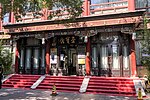Hufangqiao station
Beijing Subway stations in Xicheng DistrictBeijing Subway stubsRailway stations in China opened in 2014

Hufangqiao Station (simplified Chinese: 虎坊桥站; traditional Chinese: 虎坊橋站; pinyin: Hǔfāngqiáo Zhàn) is a station on Line 7 of the Beijing Subway. It was opened on December 28, 2014 as a part of the stretch between Beijing West railway station and Jiaohuachang and is located between Caishikou and Zhushikou.
Excerpt from the Wikipedia article Hufangqiao station (License: CC BY-SA 3.0, Authors, Images).Hufangqiao station
Shitou Hutong, Xicheng District Dashilan (首都功能核心区)
Geographical coordinates (GPS) Address Nearby Places Show on map
Geographical coordinates (GPS)
| Latitude | Longitude |
|---|---|
| N 39.8895 ° | E 116.3847 ° |
Address
石头胡同
Shitou Hutong
100032 Xicheng District, Dashilan (首都功能核心区)
Beijing, China
Open on Google Maps









